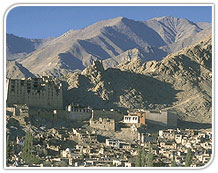Leh
City Guide
 The
main town of the region, is dominated by Sengge Namgyal's nine-storey
Palace, a building in the grand tradition of Tibetan architecture, said
to have inspired the famous Potala in Lhasa, which was built half a
century later. Above it, on Namgyal Tsemo, the peak overlooking the
town, are the ruins of the earliest royal residence at Leh, a fort built
by King Tashi Namgyal in the 16th century. The associated temples remain
intact, but they are kept locked except during the morning and evening
hours when a monk toils up the hills from Sankar Gompa to attend to the
butter-lamps in front of the images.
The
main town of the region, is dominated by Sengge Namgyal's nine-storey
Palace, a building in the grand tradition of Tibetan architecture, said
to have inspired the famous Potala in Lhasa, which was built half a
century later. Above it, on Namgyal Tsemo, the peak overlooking the
town, are the ruins of the earliest royal residence at Leh, a fort built
by King Tashi Namgyal in the 16th century. The associated temples remain
intact, but they are kept locked except during the morning and evening
hours when a monk toils up the hills from Sankar Gompa to attend to the
butter-lamps in front of the images.
Down
in the bazaar, the main sites to visit are the Jo-khang, a modern
ecumenical Buddhist temple, and the imposing mosque dating from the late
17th century almost opposite. But the pleasures of Leh are not confined
to the purposeful visiting of sites. For locals and visitors alike, a
stroll along the main bazaar, observing the varied crowd and peering
into the curio shops is an entrancing experience. A particularly
charming sight is the line of women from nearby villages sitting along
the edge of the footpath with baskets of fresh vegetables brought for
sale to town's people. Chang Gali, behind the main bazaar, is less
bustling but has intriguing little shops selling curious and jewelry;
and further on is the labyrinthine alleyways and piled-up houses of the
old city, cluttering around the foot of the palace hill. In the other
direction, down from the bazaar, are the stalls of the Tibetan traders
where you can bargain for pearls, turquoise, coral, malachite, lapis
lazuli and many other kinds of semi-precious stones and jewelry, as well
as curiously carved yak-horn boxes, quaint brass locks, china or metal
bowls, or any of a whole array of curious. When you're tired of
strolling, you can step into any of several restaurants, some of them in
the open air- in gardens, or on the sidewalk - which serve local,
Tibetan, Indian and Continental cuisine.
Or you can strike off
away from the bazaar, past Zangsti, the old coppersmith's quarte, past
the Moravian Church to the Ladakh Ecological Centre. From here there is
a footpath across the fields to Sankar Gompa- a half an hour walk.
Or
you can leave the main road from the bazaar near the Moravian Church and
turn off to Changspa, an attractive village, and practically a suburb of
Leh, lying below the hill on which stands the modern Ladakh Shanti
Stupa, accessible by a winding road. Down past the Tourist Information
Centre in the Dak-Bungalow Complex, you can follow the Fort road to
Skara, another pretty and prosperous suburb of Leh town, and admire the
earthen ramparts of Zorawar Singh's Fort, now housing army barracks.
This road continues onward, swinging around the periphery of the village
to meet the main highway near a crossroads where the roads from Srinagar
and Manali meet. A side road taking off from here traverses the interior
of Skara to meet the main highway near the airport, an excellent drive
through the heart of the sprawling village.
Too far for a
stroll, not far enough to be called a trek, there are several attractive
destinations within a 10-kms radius of Leh. Sabu, a charming village
with a small gompa, nestles between two southward-stretching spurs of
the Ladakh range about 9km away. In the same direction, but nearer town,
is Choglamsar, with the Tibetan refugee settlement including a child's
village, a handicrafts centre devoted largely to carpet-weaving, and the
Dalai Lama's prayer-gournd, Jiva-tsal. Some 8km on the Srinagar road is
the turning for Spituk Gompa, and village. On of the gompa's main
features is the chapel dedicated to the Goddess Tara, with twenty-three
images of her various manifestations.
The main town of the region, is dominated by Sengge Namgyal's nine-storey Palace, a building in the grand tradition of Tibetan architecture, said to have inspired the famous Potala in Lhasa, which was built half a century later. Above it, on Namgyal Tsemo, the peak overlooking the town, are the ruins of the earliest royal residence at Leh, a fort built by King Tashi Namgyal in the 16th century. The associated temples remain intact, but they are kept locked except during the morning and evening hours when a monk toils up the hills from Sankar Gompa to attend to the butter-lamps in front of the images.